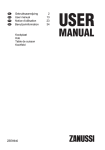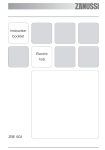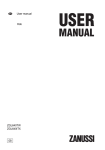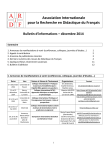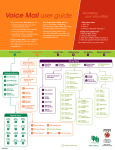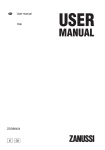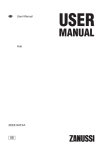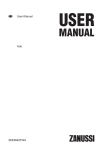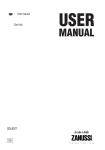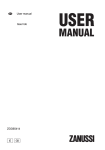Download Zanussi ZEE6940 User manual
Transcript
EN User manual Hob ZEE6940 Contents Safety information _ _ _ _ _ _ _ _ _ _ _ _ _ _ Installation _ _ _ _ _ _ _ _ _ _ _ _ _ _ _ _ _ _ _ Product description _ _ _ _ _ _ _ _ _ _ _ _ _ Operation _ _ _ _ _ _ _ _ _ _ _ _ _ _ _ _ _ _ _ Helpful hints and tips _ _ _ _ _ _ _ _ _ _ _ _ _ 2 3 5 6 6 Care and cleaning _ _ _ _ _ _ _ _ _ _ _ _ _ _ What to do if… _ _ _ _ _ _ _ _ _ _ _ _ _ _ _ _ Technical data _ _ _ _ _ _ _ _ _ _ _ _ _ _ _ _ Environment concerns _ _ _ _ _ _ _ _ _ _ _ _ 7 7 8 9 Subject to change without notice. Safety information For your safety and correct operation of the appliance, read this manual carefully before installation and use. Always keep these instructions with the appliance even if you move or sell it. Users must fully know the operation and safety features of the appliance. General safety Warning! Persons (including children) with reduced physical sensory, mental capabilities or lack of experience and knowledge must not use the appliance. They must have supervision or instruction for the operation of the appliance by a person responsible for their safety. The appliance is not intended to be operated with external timer or separated remote-control system. Child safety • Only adults can use this appliance. Children must get supervision to make sure that they do not play with the appliance. • Keep all packaging away from children. There is a risk of suffocation and physical injury. • Keep children away from the appliance during and after the operation, until the appliance is cold. Safety during operation • Remove all packaging, stickers and layers from the appliance before the first use. • Set the cooking zones to "off" after each use. • Risk of burns! Do not put cutlery or saucepan lids on the cooking surface, as they can become hot. 2 Warning! Fire danger! Overheated fats and oils can ignite very quickly. Correct operation • Do not leave the appliance unattended during operation. • Always monitor the appliance during operation. • Do not let liquids overflow into the holes of the top of the hob • Never use the hob without cookware. • Only use the appliance for domestic cooking tasks! Do not use it for commercial or industrial purposes or for any purpose other than that for which it was designed. This way, you will avoid risks to person or property. • Use only cookware with a bottom diameter applicable to the dimensions of the cooking zones. There is a risk of overheating and rupture of the glass plate (if applicable). • Do not use cookware with a diameter smaller than the cooking zone dimension - the pan handle can become hot because of the heat. • Pots must not be too near to the control zone. • Do not use the appliance as a work or a storage surface. • Never use unstable cookware to prevent from tilting and accidents. • Do not put or keep flammable liquids (or items that are wet with flammable products) and materials or fusible objects (made of plastic or aluminium) on or near the appliance. There is a risk of explosion or fire. • Use only the accessories supplied with the appliance. www.zanussi.com • Be careful when you connect the appliance to the near sockets. Do not let electricity bonds touch the appliance or hot cookware. Do not let electricity bonds tangle. • Do not use the solid hotplate with empty cookware or without cookware. • Do not put aluminium foil on parts of the appliance. How to prevent a damage to the appliance • Do not let acid liquids such as vinegar or lemon juice or agents which remove limescale touch the hob. It stains the surface. • Do not put wet pan lids on the hotplates or let hot pans cool on the hotplates. Condensation and rust can occur. • Do not let cookware boil dry in order to prevent damage to the cookware and hotplate. Disposal of the appliance • To prevent the risk of physical injury or damage – Disconnect the appliance from the power supply. – Cut off the mains cable where it connects with the appliance and discard it. – Speak to your local authorised facilities for disposal of your appliance. Installation Installation Warning! Read and follow the instructions carefully. There is a risk of injury or damage to the appliance. • Make sure that the appliance is not damaged because of transportation. Do not connect a damaged appliance. If it is necessary, speak to the supplier. • Installation and connection of the appliance to the power supply must only be done by qualified personnel. • Only use built-in appliances after you assemble the appliance into correct built-in units and work surfaces that obey the standards. • Do not change the specifications or modify this product. There is a risk of injury or damage to the appliance. • Fully obey the laws, ordinances, directives and standards in force in the country where you use the appliance (safety regulations, recycling regulations, electrical safety rules etc.). • Keep the minimum distances to other appliances and units. • Install anti-shock protection, for example install the drawers only with a protective panel directly below the appliance. • If the fixing bracket is near to the terminal block, always make sure the connection cawww.zanussi.com • • • • • ble does not come in contact with the edge of the bracket. Prevent damage of the cut surfaces of the worktop against moisture with a correct sealant! Seal the appliance to the worktop with no space left with a correct sealant. Prevent damage of the bottom of the appliance from steam and moisture, e.g. from a dishwasher or oven. Do not install the appliance adjacent to doors and below windows. Hot cookware can be hit off the hob when you open doors or windows. Disconnect the appliance from the electrical supply, before you do maintenance work or cleaning. Warning! Risk of injury from electrical current. Carefully obey the instructions for electrical connections. • The electrical mains terminal is live. • Make the electrical mains terminal free of voltage. • Install correctly to give anti-shock protection. • Loose and incorrect mains plug and socket connections can make the terminal become too hot. 3 • A qualified electrician must install the clamping connections correctly. • Use a strain relief clamp on cable. • Use the correct mains connection cable and replace the damaged mains cable with the proper cable type. Speak to your local Service Centre. The appliance must have the electrical installation which lets you disconnect the appliance from the mains at all poles with a contact opening width of minimum 3 mm. You must have correct isolation devices: line protecting cutouts, fuses (screw type fuses removed from the holder), ground leakage trips and contactors. The manufacturer is not responsible for any injury to persons and pets or damage to property caused by failure to obey these requirements. Electrical connection • Ground the appliance according to safety precautions. • Make sure that the rated voltage and type of power on the rating plate agree with the voltage and the power of the local power supply. • The appliance is fitted with a five pole terminal box whose cables are predisposed for 230 V monophase function. 1 2 3 4 5 • Do not pull the mains cable to disconnect the appliance. Always pull the mains plug. • The appliance must not be connected with an extension cable, an adapter or a multiple connection (risk of fire). Check that the ground connection is in conformity with the standard and regulations force. • The power cable must be placed in such a way that it does not touch any hot part. • Connect the appliance to the mains with a device that lets to disconnect the appliance from the mains at all poles with a contact opening width of minimum 3 mm, eg. automatic line protecting cut-out, earth leakage trips or fuse. • None of a parts of the connection cable can not get a temperature 90°C. The blue neutral cable must be connected to the terminal block label with "N". The brown (or black) phase cable (fitted in the terminal block contact marked with "L") must always be connected to the live phase. Connection cable Use only connection cable of type H05V2V2-F T90 or equivalent type. Make sure that the cable section is applicable to the voltage and the working temperature. The yellow/green earth wire must be approximately 2 cm longer than the brown (or black) phase wire. Building In min. 600 mm min. 650 mm min. 55 mm In case of different voltage, carry out the connection as shown in connection schematic table on the lower protection. • Any electrical component must be installed or replaced by the Service Force Centre technician or qualified service personnel. • Always use a correctly installed shockproof socket. • Make sure that there is an access to the mains plug after installation. 4 480 mm 30 mm 560 mm A 10 mm 3 mm 11 mm 11 mm www.zanussi.com b) Space for connections A Kitchen unit with oven The hob recess dimensions must obey the indication and the kitchen unit must be equipped with vents to let a continuous supply of air. The electrical connection of the hob and the oven must be installed separately for safety reasons and to let easy remove oven from the unit. B A) supplied seal B) supplied brackets Possibilities for insertion 50 cm2 120 cm2 360 cm2 180 cm2 Kitchen unit with door The panel installed below the hob must be easy to remove and let an easy access in case a technical assistance intervention is necessary. 30 mm a 60 mm min 20 mm (max 150 mm) b a) Removable panel Product description Cooking surface layout 1 2 180 180 mm 6 145 mm 5 mm 1 Single cooking zone 2000 W 2 Single cooking zone 2000 W 145 3 Single cooking zone 1500 W 4 Control knobs mm 3 5 Power indicator 6 Single cooking zone 1500 W 4 www.zanussi.com 5 Electric cooking zones control knobs Symbol Function Symbol Function 1 minimum heat 0 off position 6 maximum heat Operation To switch on and increase the heat setting turn the knob counterclockwise. To decrease the heat setting turn the knob clockwise. To switch off turn the knob to the 0. Power indicator is activated when either of the zones are turned on, and will stay on until the cooking zones are switched off. Before first use Put cookware containing water on each cooking zone, set the maximum position and operate the appliance for 10 min. This is to burn off the residue in the appliance. After that, operate the appliance at minimum position for 20 min. During this period, an odour and smoke can occur. This is normal. Make sure that the airflow is sufficient. After this operation, clean the appliance with a soft cloth soaked in warm water. Rapid hot plate A red dot in the middle of the plate shows a rapid hot plate. A rapid hot plate heats up faster than usual plates. The red dot is painted on the surface and can come off after some time. It does not have an effect on the performance of the appliance. The rapid hot plate can smoke and make an odour when you use it for the first time. The smoke and an odour will go off after a while. Helpful hints and tips Cookware • The bottom of the cookware must be as thick and flat as possible. Warning! Pots must not enter the control zone. Energy saving • If possible, always put the lids on the cookware. • Put cookware on a solid hotplate before you start it. • Stop the solid hotplate before the end of the cooking time to use residual heat. • For satisfactory results, the bottom of pans must have the same dimensions (or slightly larger) as solid hotplates. Do not use smaller pans. 6 Examples of cooking applications Heat setting: Use to: 1 Keeping warm 2 Gentle simmering 3 Simmering 4 Frying / browning 5 Bringing to the boil 6 Bringing to the boil / quick frying / deep-frying Information on acrylamides Important! According to the newest scientific knowledge, if you brown food (specially the one which contains starch), acrylamides can pose a health risk. Thus, we recommend that you cook at the lowest temperatures and do not brown food too much. www.zanussi.com Care and cleaning Clean the appliance after each use. Always use cookware with clean bottom. Warning! Before any maintenance or cleaning can be carried out, you must disconnect the hob from the electricity supply. The hob is best cleaned while it is still warm, as spillage can be removed more easily than if it is left to cool. Warning! Sharp objects and abrasive cleaning agents will damage the appliance. For your safety, do not clean the appliance with steam blasters or high-pressure cleaners. The stainless steel can become tarnished if it is too much heated. Refer to this you must not cook with potstones, earthenware pans or cast iron plates. Do not use aluminium foil to prevent damage the top during operation. Stainless steel parts wash with water, and then dry with a soft cloth. Scratches or dark stains have no effect on how the appliance operates. Removing the dirt: 1. Use the fine scouring powder or a scouring pad to remove the dirt. 2. Clean the appliance with a damp cloth and some detergent. 3. Heat the hotplate to a low temperature and leave to dry. 4. To maintain the hotplates, rub in a little sewing machine oil now and again and then polish off with absorbent paper. Important! For stainless steel edges of the hob use cleaner for stainless steel. The stainless steel edge of the plate can be slightly discoloured as a result of the thermal load. What to do if… Problem Possible cause and remedy The appliance does not operate. • Examine the fuse in the electrical system of the house in the fuse box. If the fuses blow time after time, speak to an authorised electrician. The cooking zone does not heat up. • Make sure that the appliance is plugged in and the electrical supply is switched on. • Make sure that you turn the correct control knob. • Examine the fuse in the electrical system of the house in the fuse box. If the fuses blow time after time, speak to an authorised electrician. The effectiveness of the hob is not satisfactory. • • • • www.zanussi.com Make sure that the hob is clean and dry. Make sure that the cookware is the correct size for the cooking zone. Make sure that the cookware has a flat bottom. Make sure that the heat setting is correct for this type of cooking. 7 If there is a fault, first try to find a solution to the problem yourself. If you cannot find a solution to the problem yourself, speak your dealer or the local Service Force Centre. If you operated the appliance incorrectly, or the installation was not carried out by a 1 registered engineer, the visit from the customer service technician or dealer may not take place free of charge, even during the warranty period. Labels supplied with the accessories bag Stick the adhesive labels as indicated below: 2 3 MOD. MOD. PROD.NO. PROD.NO. SER.NO SER.NO 03 IT DATA DATA MADE IN ITALY MODEL MOD. PROD.NO. SER.NO. 0049 TYPE 230V-50Hz IP20 MODEL 1 Stick it on Guarantee Card and send this part 2 Stick it on Guarantee Card and keep this part 3 Stick it on instruction booklet These data are necessary to help you quickly and correctly. These data are available on the supplied rating plate. • Model description ................. • Product number (PNC) ................. • Serial Number (S.N.) ................. Use the original spare parts only. They are available at Service Force Centre and approved spare parts shops. Technical data Hob dimensions Front left cooking zone 145 mm 1.5 kW Front right cooking zone 145 mm 1.5 kW Hob recess dimensions Rear left cooking zone 180 mm 2.0 kW Width: 560 mm 2.0 kW Length: 480 mm Rear right cooking zone 180 mm Width: 594 mm Length: 510 mm Total rating Hot plate rating 8 Electric supply 7.0 kW 230 V ~ 50 Hz www.zanussi.com Environment concerns The symbol on the product or on its packaging indicates that this product may not be treated as household waste. Instead it should be taken to the appropriate collection point for the recycling of electrical and electronic equipment. By ensuring this product is disposed of correctly, you will help prevent potential negative consequences for the environment and human health, which could otherwise be caused by inappropriate waste handling of this product. For more detailed www.zanussi.com information about recycling of this product, please contact your local council, your household waste disposal service or the shop where you purchased the product. Packaging material The packaging materials are friendly to the environment and can be recycled. The plastic components are identified by marking: >PE<,>PS<, etc. Discard the packaging materials as household waste at the waste disposal facilities in your municipality. 9 10 www.zanussi.com www.zanussi.com 11 397226301-A-092012 www.zanussi.com/shop












